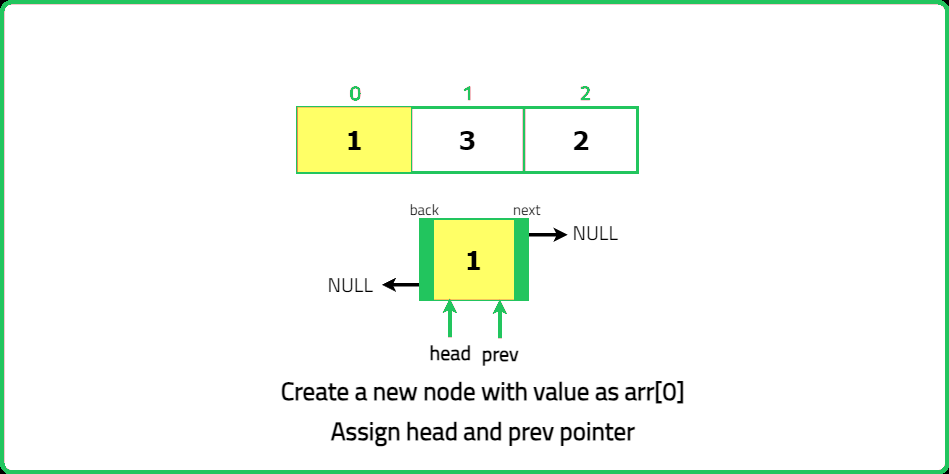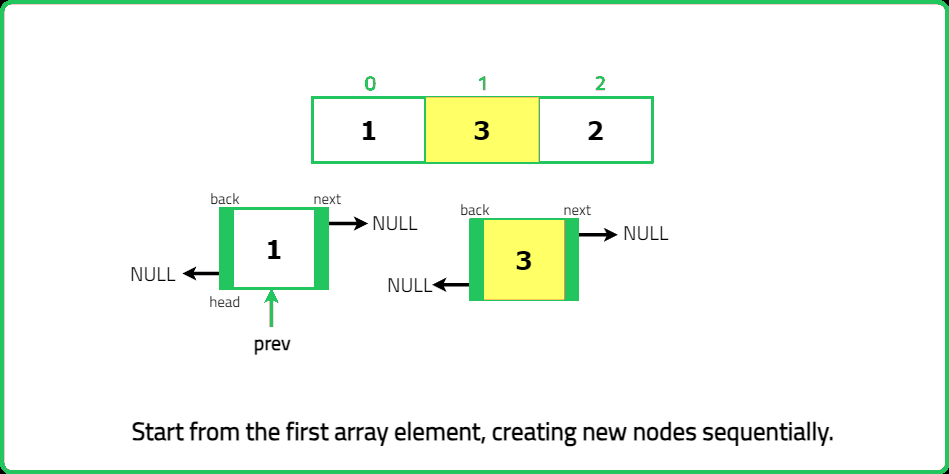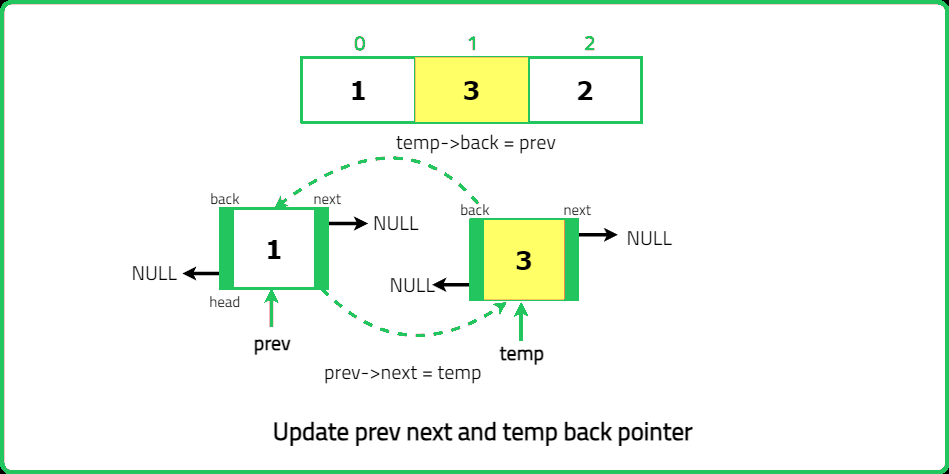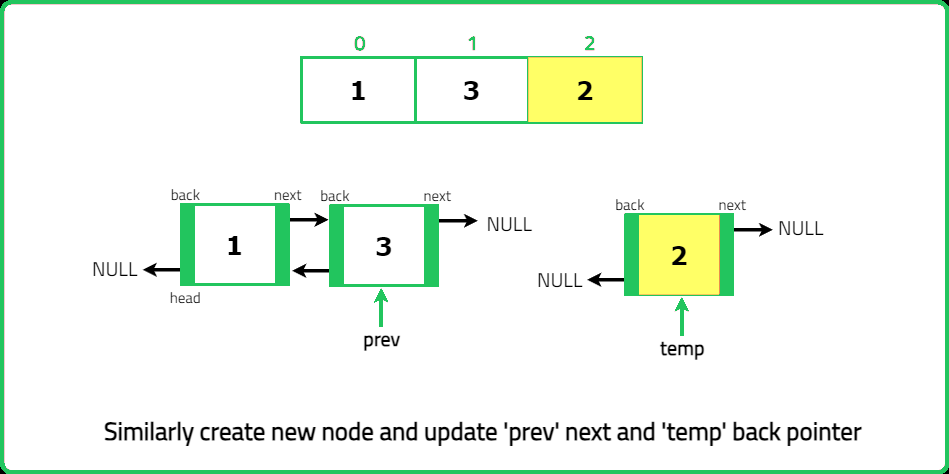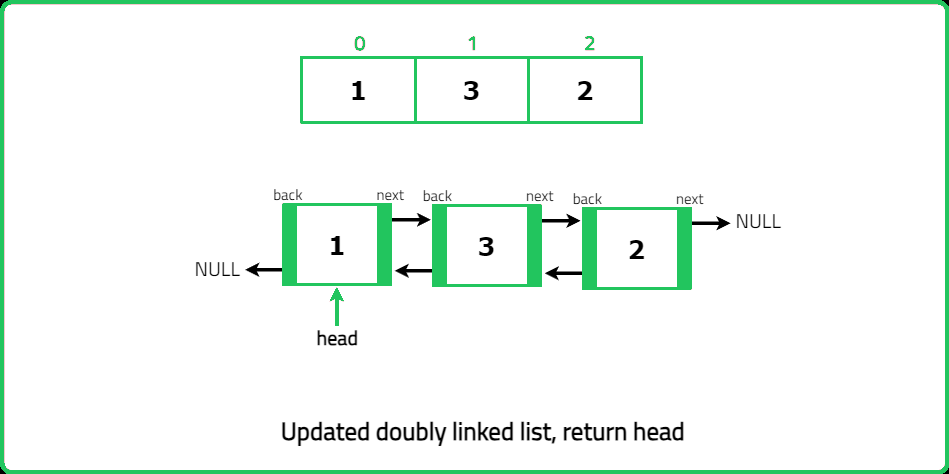1234567891011121314151617181920212223242526272829303132333435363738394041424344454647484950515253545556575859606162636465666768697071727374757677787980
#include <bits/stdc++.h>
using namespace std;
// Definition of doubly linked list
struct ListNode
{
int val;
ListNode *next;
ListNode *prev;
ListNode()
{
val = 0;
next = NULL;
prev = NULL;
}
ListNode(int data1)
{
val = data1;
next = NULL;
prev = NULL;
}
ListNode(int data1, ListNode *next1, ListNode *prev1)
{
val = data1;
next = next1;
prev = prev1;
}
};
// Solution class
class Solution {
public:
// Function to convert an array to a doubly linked list
ListNode* arrayToLinkedList(vector<int> &nums) {
// If array is empty, return nullptr
if (nums.empty()) return nullptr;
// Create head node with first element of the array
ListNode* head = new ListNode(nums[0]);
// Initialize 'prev' to the head node
ListNode* prev = head;
for (int i=1; i < nums.size(); i++) {
// Create a new node
ListNode* temp = new ListNode(nums[i], nullptr, prev);
// Update 'next' pointer
prev->next = temp;
// Move 'prev' to newly created node
prev = temp;
}
// Return head
return head;
}
};
// Helper Function to print the linked list
void printLL(ListNode* head) {
while (head != NULL) {
cout << head->val << " ";
head = head->next;
}
cout << endl;
}
int main() {
vector<int> nums = {1, 2, 3, 4, 5};
// Create an instance of Solution class
Solution sol;
// Function call to convert an array to a doubly linked list
ListNode* head = sol.arrayToLinkedList(nums);
// Print the doubly linked list
cout << "The doubly linked list is: ";
printLL(head);
return 0;
}
123456789101112131415161718192021222324252627282930313233343536373839404142434445464748495051525354555657585960616263646566676869707172737475767778
// Definition of doubly linked list
class ListNode {
int val;
ListNode next;
ListNode prev;
ListNode() {
val = 0;
next = null;
prev = null;
}
ListNode(int data1) {
val = data1;
next = null;
prev = null;
}
ListNode(int data1, ListNode next1, ListNode prev1) {
val = data1;
next = next1;
prev = prev1;
}
}
// Solution class
class Solution {
// Function to convert an array to a doubly linked list
public ListNode arrayToLinkedList(int[] nums) {
// If array is empty, return null
if (nums.length == 0) return null;
// Create head node with first element of the array
ListNode head = new ListNode(nums[0]);
// Initialize 'prev' to the head node
ListNode prev = head;
for (int i = 1; i < nums.length; i++) {
// Create a new node
ListNode temp = new ListNode(nums[i], null, prev);
// Update 'next' pointer
prev.next = temp;
// Move 'prev' to newly created node
prev = temp;
}
// Return head
return head;
}
}
// Main Class
class Main {
// Helper function to print the linked list
private static void printLL(ListNode head) {
while (head != null) {
System.out.print(head.val + " ");
head = head.next;
}
System.out.println();
}
// main method
public static void main(String[] args) {
// Declare nums as a 1D array
int[] nums = {1, 2, 3, 4, 5};
// Create an instance of Solution class
Solution sol = new Solution();
// Function call to convert an array to a doubly linked list
ListNode head = sol.arrayToLinkedList(nums);
// Print the doubly linked list
System.out.println("The doubly linked list is: ");
printLL(head);
}
}
1234567891011121314151617181920212223242526272829303132333435363738394041424344454647484950
# Definition of doubly linked list
class ListNode:
def __init__(self, data1=0, next1=None, prev1=None):
self.val = data1
self.next = next1
self.prev = prev1
# Solution class
class Solution:
# Function to convert an array to a doubly linked list
def arrayToLinkedList(self, nums):
# If array is empty, return None
if not nums:
return None
# Create head node with first element of the array
head = ListNode(nums[0])
# Initialize 'prev' to the head node
prev = head
for i in range(1, len(nums)):
# Create a new node
temp = ListNode(nums[i], None, prev)
# Update 'next' pointer
prev.next = temp
# Move 'prev' to newly created node
prev = temp
# Return head
return head
# Helper function to print the linked list
def printLL(head):
while head is not None:
print(head.val, end=" ")
head = head.next
print()
if __name__ == "__main__":
nums = [1, 2, 3, 4, 5]
# Create an instance of Solution class
sol = Solution()
# Function call to convert an array to a doubly linked list
head = sol.arrayToLinkedList(nums)
# Print the doubly linked list
print("The doubly linked list is: ")
printLL(head)
1234567891011121314151617181920212223242526272829303132333435363738394041424344454647484950515253545556575859
// Definition of doubly linked list
class ListNode {
constructor(data1 = 0, next1 = null, prev1 = null) {
this.val = data1;
this.next = next1;
this.prev = prev1;
}
}
// Solution class
class Solution {
// Function to convert an array to a doubly linked list
arrayToLinkedList(nums) {
// If array is empty, return null
if (nums.length === 0) return null;
// Create head node with first element of the array
let head = new ListNode(nums[0]);
// Initialize 'prev' to the head node
let prev = head;
for (let i = 1; i < nums.length; i++) {
// Create a new node
let temp = new ListNode(nums[i], null, prev);
// Update 'next' pointer
prev.next = temp;
// Move 'prev' to newly created node
prev = temp;
}
// Return head
return head;
}
}
// Helper function to print the linked list
function printLL(head) {
while (head !== null) {
process.stdout.write(head.val + " ");
head = head.next;
}
console.log();
}
const main = () => {
let nums = [1, 2, 3, 4, 5];
// Create an instance of Solution class
let sol = new Solution();
// Function call to convert an array to a doubly linked list
let head = sol.arrayToLinkedList(nums);
// Print the doubly linked list
console.log("The doubly linked list is: ");
printLL(head);
}
main();
